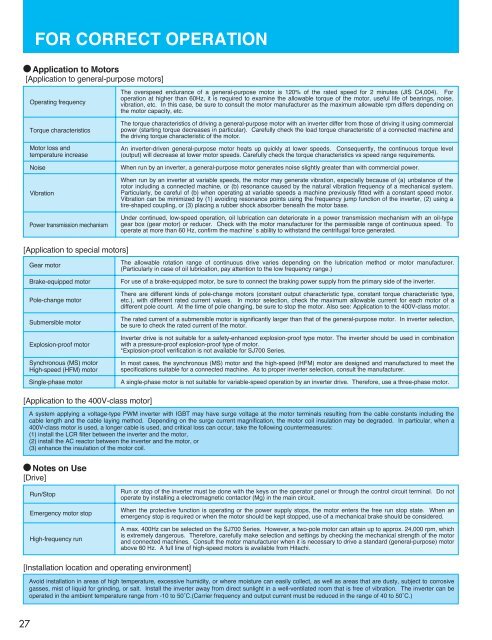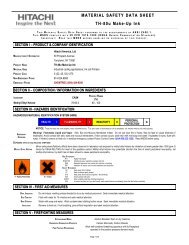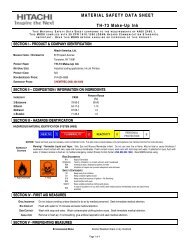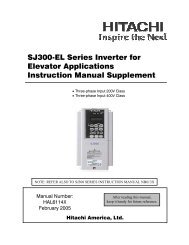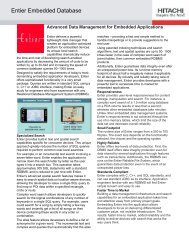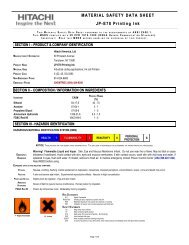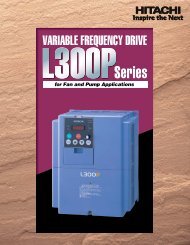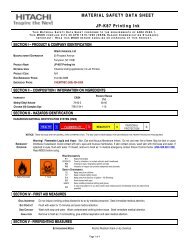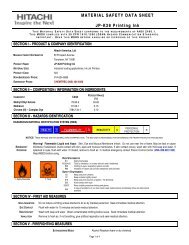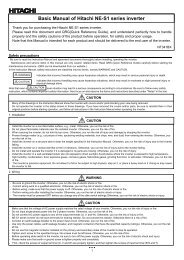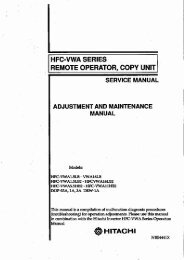SJ700 Series Brochure - Hitachi America, Ltd.
SJ700 Series Brochure - Hitachi America, Ltd.
SJ700 Series Brochure - Hitachi America, Ltd.
You also want an ePaper? Increase the reach of your titles
YUMPU automatically turns print PDFs into web optimized ePapers that Google loves.
FOR CORRECT OPERATIONApplication to Motors[Application to general-purpose motors]Operating frequencyTorque characteristicsMotor loss andtemperature increaseNoiseVibrationPower transmission mechanismThe overspeed endurance ofa general-purpose motor is 120% ofthe rated speed for 2 minutes (JIS C4,004). Foroperation at higher than 60Hz, it is required to examine the allowable torque of the motor, useful life of bearings, noise,vibration, etc. In this case, be sure to consult the motor manufacturer as the maximum allowable rpm differs depending onthe motor capacity, etc.The torque characteristics of driving a general-purpose motor with an inverter differ from those of driving it using commercialpower (starting torque decreases in particular). Carefully check the load torque characteristic of a connected machine andthe driving torque characteristic ofthe motor.An inverter-driven general-purpose motor heats up quickly at lower speeds. Consequently, the continuous torque level(output) will decrease at lower motor speeds. Carefully check the torque characteristics vs speed range requirements.When run by an inverter, a general-purpose motor generates noise slightly greater than with commercial power.When run by an inverter at variable speeds, the motor may generate vibration, especially because of(a) unbalance oftherotor including a connected machine, or (b) resonance caused by the natural vibration frequency of a mechanical system.Particularly, be careful of (b) when operating at variable speeds a machine previously fitted with a constant speed motor.Vibration can be minimized by (1) avoiding resonance points using the frequency jump function of the inverter, (2) using atire-shaped coupling, or (3) placing a rubber shock absorber beneath the motor base.Under continued, low-speed operation, oil lubrication can deteriorate in a power transmission mechanism with an oil-typegear box (gear motor) or reducer. Check with the motor manufacturer for the permissible range of continuous speed. Tooperate at more than 60 Hz, confirm the machine , s ability to withstand the centrifugal force generated.[Application to special motors]Gear motorThe allowable rotation range ofcontinuous drive varies depending on the lubrication method or motor manufacturer.(Particularly in case ofoil lubrication, pay attention to the low frequency range.)Brake-equipped motorPole-change motorSubmersible motorExplosion-proofmotorSynchronous (MS) motorHigh-speed (HFM) motorSingle-phase motorFor use ofa brake-equipped motor, be sure to connect the braking power supply from the primary side ofthe inverter.There are different kinds of pole-change motors (constant output characteristic type, constant torque characteristic type,etc.), with different rated current values. In motor selection, check the maximum allowable current for each motor of adifferent pole count. At the time of pole changing, be sure to stop the motor. Also see: Application to the 400V-class motor.The rated current ofa submersible motor is significantly larger than that ofthe general-purpose motor. In inverter selection,be sure to check the rated current ofthe motor.Inverter drive is not suitable for a safety-enhanced explosion-proof type motor. The inverter should be used in combinationwith a pressure-proofexplosion-prooftype ofmotor.*Explosion-proof verification is not available for <strong>SJ700</strong> <strong>Series</strong>.In most cases, the synchronous (MS) motor and the high-speed (HFM) motor are designed and manufactured to meet thespecifications suitable for a connected machine. As to proper inverter selection, consult the manufacturer.A single-phase motor is not suitable for variable-speed operation by an inverter drive. Therefore, use a three-phase motor.[Application to the 400V-class motor]A system applying a voltage-type PWM inverter with IGBT may have surge voltage at the motor terminals resulting from the cable constants including thecable length and the cable laying method. Depending on the surge current magnification, the motor coil insulation may be degraded. In particular, when a400V-class motor is used, a longer cable is used, and critical loss can occur, take the following countermeasures:(1) install the LCR filter between the inverter and the motor,(2) install the AC reactor between the inverter and the motor, or(3) enhance the insulation ofthe motor coil.Notes on Use[Drive]Run/StopEmergency motor stopHigh-frequency runRun or stop ofthe inverter must be done with the keys on the operator panel or through the control circuit terminal. Do notoperate by installing a electromagnetic contactor (Mg) in the main circuit.When the protective function is operating or the power supply stops, the motor enters the free run stop state. When anemergency stop is required or when the motor should be kept stopped, use ofa mechanical brake should be considered.A max. 400Hz can be selected on the <strong>SJ700</strong> <strong>Series</strong>. However, a two-pole motor can attain up to approx. 24,000 rpm, whichis extremely dangerous. Therefore, carefully make selection and settings by checking the mechanical strength of the motorand connected machines. Consult the motor manufacturer when it is necessary to drive a standard (general-purpose) motorabove 60 Hz. A full line of high-speed motors is available from <strong>Hitachi</strong>.[Installation location and operating environment]Avoid installation in areas ofhigh temperature, excessive humidity, or where moisture can easily collect, as well as areas that are dusty, subject to corrosivegasses, mist of liquid for grinding, or salt. Install the inverter away from direct sunlight in a well-ventilated room that is free of vibration. The inverter can beoperated in the ambient temperature range from -10 to 50ûC.(Carrier frequency and output current must be reduced in the range of 40 to 50ûC.)27


